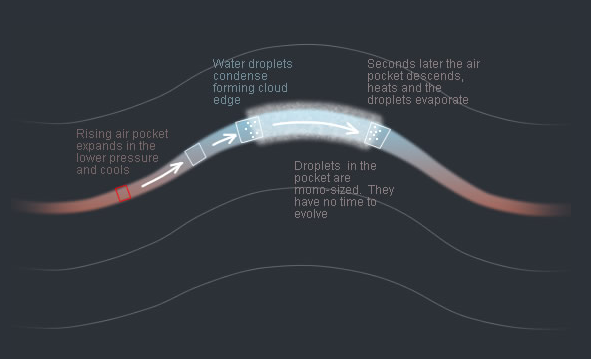Lenticular Cloud, Crimean Astrophysical Observatory
Lenticular Clouds: A Fascinating Phenomenon at the Crimean Astrophysical Observatory
Lenticular clouds are a captivating atmospheric optics phenomenon that often leaves observers in awe. These unique cloud formations, characterized by their lens-like shape, have been observed and studied at various locations around the world, including the Crimean Astrophysical Observatory (CrAO) in Ukraine. In this article, we will delve deeper into the intricacies of lenticular clouds and explore their connection to atmospheric optics.
At first glance, the photographs captured by Serge Stepanenko at the Crimean Astrophysical Observatory reveal the sheer beauty and grandeur of lenticular clouds. The multilayered structure of these clouds, illuminated by the reddened rays of a low sun, dominates the sky and imparts a thin red lining to the lower cumulus clouds nearby. However, their aesthetic appeal is not the only reason why lenticular clouds are of interest to scientists and enthusiasts alike.
The key connection between lenticular clouds and atmospheric optics lies in the vivid iridescent effects they exhibit. These striking visual displays are a direct result of the unique properties of the cloud droplets themselves. Unlike other cloud formations, lenticular clouds possess nearly mono-sized droplets, which give rise to their vivid iridescence.
Although lenticular clouds may appear stationary in the sky, they are actually formed by atmospheric waves in the lee of mountains or other meteorological disturbances. As air rushes across these waves, pockets of air rise and expand adiabatically, leading to a decrease in temperature. When the cooling is sufficient, water vapor condenses into numerous small droplets, marking the upstream edge of the lenticular cloud. Subsequently, as the air pocket descends with the wave, it becomes compressed, causing an increase in temperature and resulting in the evaporation of the droplets.
The dynamic nature of lenticular clouds becomes evident as they mark the crests of atmospheric waves and serve as boundaries for droplet condensation and evaporation. These clouds provide a visual representation of the intricate interplay between various atmospheric factors and phenomena.
While the lenticular clouds captured in the photographs from the Crimean Astrophysical Observatory are visually stunning, they are considered too large and optically thick to display iridescence. Smaller, thinner lenticular clouds are best suited for showcasing this captivating optical effect.
In conclusion, lenticular clouds are an enchanting atmospheric optics phenomenon that has been observed and studied at the Crimean Astrophysical Observatory. These lens-like cloud formations offer a visual spectacle, with their vivid iridescent effects adding to their allure. Understanding the processes behind the formation and evolution of lenticular clouds provides valuable insights into the intricate workings of our atmosphere. So, next time you spot a lenticular cloud gracing the sky, take a moment to appreciate its beauty and marvel at the wonders of atmospheric optics.

Lenticular Cloud imaged by Serge Stepanenko at the Crimean Astrophysical Observatory (CrAO), Ukraine. Scroll right for the full image. �Serge Stepanenko, shown with permission.

The multilayered lenticular cloud lit by the reddened rays of a low sun dominates the sky. Light from it gives a thin red lining to the lower and nearer cumulus at far right.
The connection with atmospheric optics? Lenticular clouds are famous for vivid iridescent effects. They arise from the special properties of the clouds' droplets.
Lenticular clouds appear more or less stationary in the sky but air is rushing across them. They are wave clouds formed on the upper parts of atmospheric waves in the lee of mountains or some other meteorological disturbance.
A pocket of air rising with one of the waves expands as it is forced to ascend. There is no transfer of heat and the expansion is therefore adiabatic. The work done in expanding is at the expense of the pocket’s heat content and thus the air temperature falls. When the cooling is sufficient, water vapour condenses into a host of small, fresh droplets and this marks the upstream edge of the lenticular cloud. Seconds later the air pocket, now laden with droplets, starts to descend with the wave. The pocket is compressed and its temperature increases again. The droplets evaporate - end of cloud.
Lenticular clouds are very dynamic objects marking the crests of atmospheric waves and the boundaries of droplet condensation and evaporation.
Optics? The cloud droplets have no time to evolve by coalescence or preferential evaporation of small ones to feed larger droplets. The droplets are nearly mono-sized. Mono-sized droplets give vivid iridescence. The monsters pictured here are too large and optically thick to show iridescence, smaller thinner lenticulars are best.
Note: this article has been automatically converted from the old site and may not appear as intended. You can find the original article here.
Reference Atmospheric Optics
If you use any of the definitions, information, or data presented on Atmospheric Optics, please copy the link or reference below to properly credit us as the reference source. Thank you!
-
<a href="https://atoptics.co.uk/blog/lenticular-cloud-crimean-astrophysical-observatory/">Lenticular Cloud, Crimean Astrophysical Observatory</a>
-
"Lenticular Cloud, Crimean Astrophysical Observatory". Atmospheric Optics. Accessed on November 26, 2024. https://atoptics.co.uk/blog/lenticular-cloud-crimean-astrophysical-observatory/.
-
"Lenticular Cloud, Crimean Astrophysical Observatory". Atmospheric Optics, https://atoptics.co.uk/blog/lenticular-cloud-crimean-astrophysical-observatory/. Accessed 26 November, 2024
-
Lenticular Cloud, Crimean Astrophysical Observatory. Atmospheric Optics. Retrieved from https://atoptics.co.uk/blog/lenticular-cloud-crimean-astrophysical-observatory/.